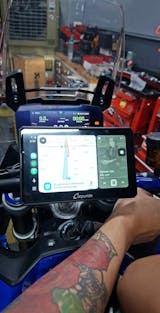Riding a motorcycle offers unmatched freedom and thrill, but it also comes with significant risks. Unlike driving a car, where you're protected by a metal shell, motorcyclists are exposed to the elements and vulnerable in the event of a crash. To truly enjoy the ride while staying safe, it's crucial to adopt the following key safety practices.
Here's a brief preview lists:
-
Check the weather before you ride
-
Inspect your bike with T-CLOCS checklist
-
Always gear up for every ride
-
Be visible to others
-
Ride defensively
-
Stay sober and focused
-
Stay a safe following distance
-
Ride within your comfort zone
-
Stay alert to your surroundings
-
Get enough rest before riding
-
Carry a first-aid kit
-
Maintain your motorcycle regularly
-
Check the Weather Before Your Ride
Before you head out, always check the weather forecast. Motorcycling leaves you exposed, so even minor weather changes can quickly become dangerous.
A sudden downpour can turn roads slick, making it harder to maintain control. Strong winds might push you off course, and low visibility can make it difficult for other drivers to see you. To avoid these risks, plan your ride around the weather. If the forecast looks bad, it’s better to delay or adjust your route.
A friend of mine learned this the hard way. He once ignored a rain warning, thinking it wouldn’t be too bad. Halfway through his ride, the skies opened up, and the wet roads made every turn feel treacherous. He had to pull over and wait out the storm, wishing he’d checked the weather more carefully. Now, he never skips that step, knowing it could save him from a dangerous situation.
-
Inspect Your Bike with T-CLOCS Checklist
Before you set off, it’s crucial to give your bike a thorough inspection. A quick check can prevent small issues from becoming big problems on the road.
Start by running through the T-CLOCS checklist: Tires, Controls, Lights, Oil, Chassis, and Stands. Make sure your tires are properly inflated and free of any cuts or wear that could cause a blowout. Test your brakes and throttle to ensure they’re responsive. Check your lights and signals—they’re essential for staying visible, especially in low-light conditions. Don’t forget to look over your oil levels and ensure there are no leaks. Lastly, give the chassis and stands a once-over to make sure everything is secure and in good working order.
Skipping this step can lead to trouble. Even a slight wobble in his front tire can lead to a serious accident. By taking just a few minutes to inspect your bike, you can spot potential issues before they happen.
-
Always Gear Up for Every Ride
No matter how short the ride, always wear the right gear, which is your first line of defense in case of an accident.
Start with a DOT-approved full-face helmet—it’s the most critical piece of gear you’ll wear. It protects your head and face from impacts and debris.
Next, opt for riding jackets made from leather or reinforced textile materials. These jackets often come with built-in armor on the elbows, shoulders, and back to protect you in a fall. Riding jean pants are another key item; these are specially designed with Kevlar or other abrasion-resistant materials to guard against road rash.
Don’t forget to wear gloves and riding boots to protect your hands, wrists and ankles as well.

-
Be Visible to Others
One of the biggest challenges motorcyclists face is being visbile to other drivers. Cars and trucks have blind spots, where motorcycles can easily get in.
A useful tip is that always use your headlights, even during the day. A running headlight makes it easier for other drivers to notice you. In addition to headlights, turn signals also work for you. It is advised to use them well in advance when changing lanes or making turns.
Another important tip is wearing bright and reflective gear. Opt for jackets, helmets, and other gear with high-visibility colors like neon yellow or orange. You can also add reflective tape to your bike and gear, which greatly enhances visibility in low-light conditions, such as dawn, dusk, or rainy weather.
-
Ride defensively
Defensive riding means always being prepared for the unexpected and assuming that other drivers might not notice you.
One key strategy is to avoid blind spots. Cars and trucks have areas where their mirrors can’t see you, and if you’re in one of these spots, the driver might change lanes or turn without noticing you. Position yourself where you’re most visible—either slightly ahead or behind other vehicles, never directly beside them.
Be especially cautious at intersections as well—this is where most motorcycle accidents happen. Slow down, cover your brakes, and look out for vehicles making sudden turns or running red lights. Even if you have the right of way, it’s better to wait a moment and make sure the coast is clear.
-
Stay Sober and Focused
Riding a motorcycle demands your full attention and quick reflexes for a long time.
Don't ride after taking alcohol, and even certain medications. They can impair your judgment and slow your reaction time.
In addition to avoiding substances, it’s important to stay mentally alert. Riding while distracted can be just as hazardous as riding under the influence. Keep your focus on the road and your surroundings—this isn’t the time to be fiddling with your phone or daydreaming.
Fatigue is another factor that can significantly affect your riding. If you’re feeling tired, it’s better to take a break than to push through. A short rest can help you recharge and return to the road with sharper focus.
I remember a fellow rider share his experience on the web. He once rode home after a long day, feeling exhausted. He didn’t realize how much fatigue had dulled his senses until he missed a sharp curve and nearly went off the road.
Using smart motorcycle radio like the Carpuride W702 can also help keep you focused. The motorcycle CarPlay offers connection with your phones, and you can handle all the information on one screen. In addition, it features Bluetooth for motorcycle radio for providing clear, hands-free navigation tips and communication. So it allows you to keep your eyes on the road and your mind on the ride.

-
Stay a Safe Following Distance
Keeping a safe distance from the vehicle in front of you is crucial for avoiding accidents. Unlike cars, motorcycles can stop quickly, but you still need enough space to react to sudden stops or obstacles.
A good rule of thumb is to maintain at least a four-second gap between you and the vehicle ahead in good conditions. This gives you enough time to react if the driver brakes suddenly or swerves. If the weather is bad, or if you’re riding in heavy traffic, increase that distance to give yourself even more room to maneuver safely.
By maintaining a safe following distance, you create a buffer zone that can be the difference between a close call and a serious accident.
-
Ride Within Your Comfort Zone
Every rider has a different skill level and comfort zone, and it’s important to stay within yours when you’re on the road.
If you’re new to riding, it’s wise to take it slow and gradually build up your skills. Consider taking a motorcycle safety course to boost your confidence and learn advanced techniques.
Even experienced riders need to recognize their limits. Some of them are easy to get caught up in the thrill of the ride and push too hard, but that’s when accidents can happen.
Remember, it’s not about proving how fast or skilled you are—it’s about riding safely and making it home in one piece.
-
Pay Attention to Your Surroundings
Staying aware of your surroundings is one of the most important aspects of safe riding. The road can present countless unexpected hazards that will impact your riding safety.
As you ride, constantly scan the road ahead and around you. Look out for uneven pavement, gravel, or oil patches that could cause your tires to slip. And keep an eye out for other vehicles—watch for sudden lane changes, distracted drivers, and cars pulling out from side streets.
It’s also important to be mindful of less obvious hazards. For instance, animals darting across the road, children playing near the street, or pedestrians stepping into your path can all create sudden, dangerous situations.
Make paying close attention to your surroundings to be your customization. It’s a habit that can keep you out of harm’s way and make your rides more enjoyable.
-
Get Enough Rest before Riding
Fatigue is a silent danger. Riding a motorcycle requires full concentration and quick reflexes, and when you’re tired, both of these are compromised.
Before you head out, make sure you’re well-rested. During a long ride. If you feel drowsy, it’s better to delay your trip or take a break until you’re fully alert. Riding when tired not only affects your reaction time but also your judgment, making it harder to spot and respond to potential hazards on the road. Stopping every couple of hours to stretch, hydrate, and rest can help keep fatigue at bay and ensure you stay sharp. Even a short break can make a big difference in your focus and stamina.
-
Carry a first-aid kit
Having a first-aid kit with you on your motorcycle is a simple but important step in being prepared for emergencies. Accidents can happen anytime, anywhere, and having basic medical supplies on hand can make a big difference in the outcome.
Your first-aid kit should include essentials like bandages, antiseptic wipes, pain relievers, and any personal medications you might need. It’s also wise to include a small pair of scissors, adhesive tape, and sterile gauze pads. These items can help you manage minor injuries on the spot or provide initial care until professional help arrives.
Learning basic first-aid and CPR is also valuable. In an emergency, knowing how to properly apply a bandage, stop bleeding, or perform CPR could save a life—yours or someone else’s.
-
Maintain Your Motorcycle Regularly
A well-maintained bike is less likely to break down and better equipped to handle the demands of the road, which in turn reduces the risk of accidents.
Begin by following the manufacturer’s recommended maintenance schedule, which typically includes regular oil changes, brake inspections, tire checks, and ensuring all fluids are at the proper levels. Pay close attention to your tires—they should be properly inflated and free from cracks, punctures, or excessive wear.
Brakes are another critical component that require regular inspection. Ensure your brake pads aren’t worn down and that your brake lines are free of leaks. The chain or belt drive should also be checked and adjusted regularly to avoid slippage or excessive wear.
Finally, don’t forget about the electrical system. Check that all lights, indicators, and the horn are functioning properly. Good visibility and clear communication with other drivers are essential for safe riding.
Enjoy Your Safe Riding Now!
Riding a motorcycle is all about enjoying the journey while staying safe. By following these safety tips, you can minimize risks and focus on the thrill of the ride. Remember, safety doesn't take away from fun—it enhances it.
Carpuride is here to support your ride with professional motorcycle display screens with CarPlay and Android Auto, always prioritizing your safety and riding experience.
Related Reading:
Best 10 MotorCycle Upgrades and Modifications You Should Try















